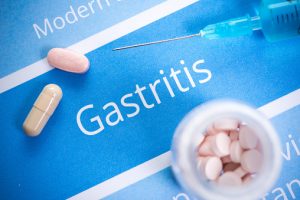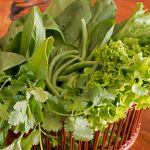 Gastritis is an inflammation of the stomach lining primarily caused by H.pylori bacteria (although it may have other causes as well). Depending on your typical diet, your gastritis may improve or worsen, or even progress to stomach ulcers. That’s why following a gastritis diet is so important to make sure your condition improves rather than aggravate.
Gastritis is an inflammation of the stomach lining primarily caused by H.pylori bacteria (although it may have other causes as well). Depending on your typical diet, your gastritis may improve or worsen, or even progress to stomach ulcers. That’s why following a gastritis diet is so important to make sure your condition improves rather than aggravate.
Symptoms of gastritis include bloating, feeling of fullness, and pain. In order to reduce your symptoms, you will want to follow a gastritis-friendly diet and also be aware of the foods that can worsen your condition. Below are the foods to enjoy along with the foods to avoid when treating and living with gastritis.
Gastritis diet: Foods to limit or avoid
Advertisement
Each person affected by gastritis will react to foods differently, so not all foods on the below list may apply to you. It is worth a shot, though, to try and limit or avoid these items, as you may experience improvements in your condition.
Generally speaking, spicy foods, high fat foods, chocolate, and seasonings irritate the stomach and often trigger the gastritis symptoms. Here is a list of foods you should limit or avoid if you are living with gastritis.
- Hot cocoa and cola
- Whole milk and chocolate milk. Most people think that dairy is a good choice for soothing an upset stomach and blocking the effects of acids. However, due to its calcium and amino acid content, dairy may actually stimulate the release of more acid production, making the symptoms of gastritis worse.
- Peppermint and spearmint tea
- Regular and decaf coffee. Both types of coffee can make gastritis symptoms worse because it is acidic in nature
- Green and black tea, with or without caffeine
- Drinks that contain alcohol
- Orange and grapefruit juices. These are citrus fruits that contain a high amount of natural acid and can trigger the release of pain-causing neurotransmitters in people with gastritis.
- Black and red pepper
- Garlic powder
- Chili powder
- Dairy foods made from whole milk or cream
- Spicy or strongly flavored cheeses, such as jalapeno or black pepper
- Highly seasoned, high-fat meats, such as sausage, salami, bacon, ham, and cold cuts
- Hot peppers, chili peppers
- Onions and garlic
- Tomato products, such as tomato paste, tomato sauce, or tomato juice. Similar to citrus fruits, tomatoes are quite acidic and can irritate a sensitive stomach. While it may be ok to eat tomato products in smaller amounts, it’s best to avoid them if you suffer from gastritis.
- Refined or processed foods. This includes white bread, pasta, products with added sugar, factory-farm meat, trans fats, refined vegetable oils, fried foods, and pasteurized dairy products. These items can trigger food allergies and increase inflammation in the gut.
- Alcohol can erode the stomach lining and increase the level of inflammation. Moderate drinking may not induce gastritis symptoms, but there are some people who cannot drink any amount of alcohol without triggering gastritis symptoms.
 Gastritis diet: Foods to eat
Gastritis diet: Foods to eat
High-antioxidant foods: Food items high in vitamin C, vitamin A, and flavonoids have been shown in prior research to help lower stomach inflammation and reduce the risk of digestive disorders. The best sources of antioxidants are brightly colored fresh fruits and vegetables. According to researchers at the University of Maryland Medical Center, fresh fruits, herbs/spices, and veggies that are especially beneficial for gastritis include onions, garlic, squash, bell peppers, leafy greens, artichoke, asparagus, celery, fennel, sea vegetables, ginger, turmeric, cruciferous veggies, berries, apples, and cranberries.
Probiotic foods: These include cultured veggies, kombucha, yogurt, and kefir, which have a multitude of beneficial effects on almost every aspect of the body. Probiotics help to reduce inflammation, regulate bowel movements, and control reactions to food allergies. Probiotic bacteria such as Lactobacillus bulgaricus may even be able to regulate how much stomach acid is produced, effectively reducing gastritis symptoms.
Licorice, fennel or anise: A traditional folk remedy for a number of different kinds of digestive complaints. Licorice root contains a compound called glycyrrhizin, which is known for its soothing effects on the stomach and strengthening ability within the GI tract. Additional effects of glycyrrhizin have been found to include anti-inflammatory, anti-diabetic, antioxidant, antitumor, antimicrobial, and antiviral properties.
High fiber foods: Fiber has proven to be beneficial for reducing gastritis and other digestive disorders. A previous study done at Harvard School of Public Health found that high fiber diets were associated with a reduced risk of developing stomach ulcers by up to 60 percent. Greats sources of fiber include nuts like almonds, seeds like chia or flax, soaked legumes/beans, and sprouted whole grains.
Healthy fats and proteins: Great sources include grass-fed meat, wild-caught fish, cage-free eggs, or pasture-raised poultry. Healthy fats and proteins can help repair the gut wall and reduce inflammation-like symptoms. Fish, such as salmon or sardines, are also a great source of omega-3s, which can further keep inflammation at bay and be beneficial for gastritis sufferers. Other healthy fats include coconut or olive oil, avocado, grass-fed butter, and ghee.
Other considerations for gastritis diet
In addition to avoiding trigger foods and consuming gastritis-friendly items, there are other considerations to keep in mind when dealing with gastritis. For example, you should avoid eating meals prior to bed. Rather than eating a few large meals, you should consume smaller ones more frequently.
Lifestyle changes can help your gastritis as well, like quitting smoking, reducing stress, limiting or avoiding nonsteroidal anti-inflammatory drugs (NSAIDs), reducing your risk of H.pylori by practicing proper hygiene and safe food preparation techniques, and cutting out chewing gum as it increases gastric acid secretion. These factors can worsen your condition and prompt gastritis to progress to ulcers.
Gastritis diet plan
Here is a diet plan to help you structure your daily meals.
Beverages: Drink six to eight glasses of water daily and steer clear of the above mentioned beverages that may cause further irritation.
Breads and starches: You can consume six to 10 servings of the following breads and starches:
- 1/2 cup cooked pasta, noodles, or macaroni
- 1/2 cup cooked rice or cream of rice
- 1/2 cup cream of wheat or oatmeal
- 3/4 cup dry cereal
- 1/2 cup mashed potatoes
- 1 medium roll or bun
- 1 slice bread
- 6 saltine crackers
- ½ cup of cooked pasta
- ½ cup of cooked rice
- ½ cup of cream of wheat or oatmeal
- ¾ cup of dry cereal
- ½ cup of mashed potatoes
- 1 medium roll or bun
- 1 slice of bread
- 6 saltine crackers
Fruits: Consume two to four servings of the following fruits:
- 1 medium apple, pear, peach, or orange
- ½ cup of applesauce or canned fruit
- 15 grapes
- 1 kiwi
- 1 ¼ cup of melon or berries
- ½ cup of mild juices
- 1 small banana
Vegetables: Consume two to four servings from the below list:
- ½ cup of cooked vegetables
- 1 cup fresh vegetables
- 2 cups of green salad
Meat or meat substitutes: Eat two to four servings of the below list:
- 1 cup of casserole from approved foods
- ½ cup of low-fat cottage cheese
- 2 tablespoons of peanut butter
- 2 ounces of semi-hard low fat cheese
- 2 scrambled or soft cooked eggs
- 2 to 3 ounces of tender meat, fish, seafood, turkey, or chicken
- 3 ounces of tofu
Milk and dairy: Eat two to three servings from the below list:
- ½ cup of custard or pudding
- ½ cup of low-fat ice cream or ice milk
- 1 cup of low-fat milk or milk drink
- 1 cup of low-fat yogurt
Soups: Eat up to three servings of one cup of broth or bouillon.
Fats: Consume two to four servings from the list below:
- 1 teaspoon of butter or margarine
- 1 teaspoon of oil
- 1 tablespoon of salad dressing
Advertisement
Don’t forget to stay clear of the foods listed in the foods to avid section.
Diet tips for gastritis
Now that you are aware of the foods you can and cannot eat, as well as serving sizes, here are some additional tips to help you along the way:
- Have regular meals, but don’t eat too often.
- Milk and dairy should be limited to three servings or less.
- Alcohol, black pepper, and chili powder should be completely avoided.
- Caffeine increases stomach acid so caffeinated products should be limited or avoided.
- High fiber foods are highly recommended.
- Foods that cause gas should be avoided, including broccoli, cabbage, onions, milk, cooked beans and peas, and some fruits. Listen to your body to see what is causing you discomfort.
- Eat broccoli. It contains a nutrient called sulforaphane that has been medically proven to kill H. pylori bacteria, a cause of stomach ulcers. Sulphoraphane supplements can also be purchased.
- Include probiotics into your diet. They’re great for providing the body with beneficial bacteria that colonize the digestive system, helping to absorb and digest nutrients.
- Commit to your gastritis diet choices. None of your diet choices will make a significant impact if you don’t adhere to them in the long term. Treating chronic cases of stomach pain and gastritis is more or less a lifestyle change and one that needs your full commitment in order to benefit from their results.
- Avoid trigger foods that you know will cause you to experience symptoms. This will you prevent damage to your gut. Some produce to generally avoid include: sweets, sodas, excessive coffee intake, energy drinks and foods with trans fats.
- Drinks water. Staying hydrated not only helps prevent gastritis symptoms from acting up they also help flush away harmful toxins.
Ways to prevent gastritis include eating slowly and chewing your food thoroughly, avoiding eating on a full stomach, and consuming smaller meals throughout the day.
